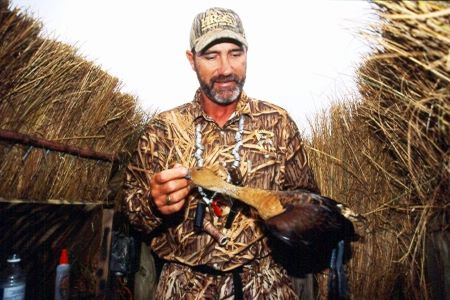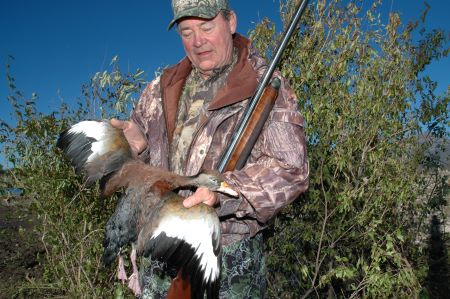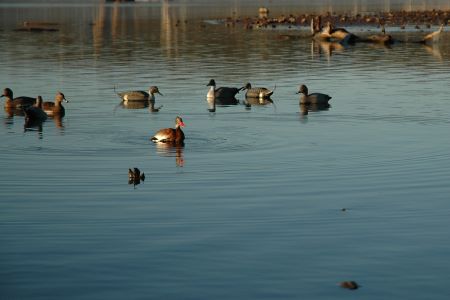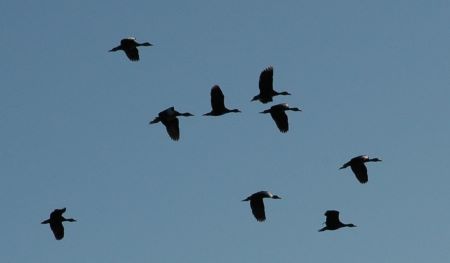Moving into the U.S., Whistling Ducks Create More Hunting Opportunities
Sounding like squeaky wheels needing grease, about 50 squealing long-necked birds circled overhead before settling into the water just outside our decoys.
These birds looked like no other North American waterfowl. In flight, the gangly birds stretched out their elongated necks and dangled long legs behind them, looking more like an ibis than a duck. Their wings beat strong, but slow, more like geese than the frenzied flapping of other ducks. They also stand upright like geese and easily walk on land.

Mexicans call them pichichi, which mimics their distinctive, shrill and almost constant “pe-che-che” calls. On the north side of the border, some people call them Mexican squealers.
Black-bellied whistling ducks sport red bills and thin, white eye rings. Their plumage ranges from chestnut brown to gray with a black belly, as the name indicates. White wing tips make excellent field marks in flight. Rich orange-brown in color, fulvous whistling ducks exhibit some white trimming along their flanks with dark blue bills, legs and feet.
Just a few years ago, waterfowlers seldom saw either species north or east of Houston. Historically, the marshes and rice fields along the lower Texas coast offered the best place north of the Rio Grande to hunt these birds. Many birds congregate in the lower Laguna Madre area. However, these delicious odd ducks could become more common in game bags as both species expanded their range northward and eastward in recent years.

Increasing numbers of them now breed in the United States and migrate to Mexico or farther south for the winter. Sportsmen in some southern states bag a few whistlers before they head south, but outside of Florida or South Texas, most disappear before opening day. Waterfowlers frequently see them during the September teal seasons, but can’t shoot them at that time.
“Black-bellied whistling ducks seem to be expanding into the Mississippi Alluvial Valley and the Gulf Coast Prairie,” explained Daniel P. Collins, a U.S. Fish and Wildlife Service migratory bird biologist in Albuquerque, N.M. “They are everywhere in Texas, Louisiana and Florida. Fulvous whistling ducks are more on the upper Texas coast and in Louisiana.”

Each year, sportsmen bag more of them in marshes along the Gulf Coast as well as rice fields in Louisiana, Arkansas and Mississippi. The birds also congregate around major rivers. Highly gregarious, whistling ducks can become quite numerous locally and form up in huge flocks.
“I’ve seen more than 25,000 black-bellied whistling ducks around grain elevators along the Mississippi River,” observed Larry Reynolds, a Louisiana Department of Wildlife and Fisheries waterfowl biologist. “There’s a long strip of bare dirt along the river with several islands in the middle of a backwater and several other spots where they congregate.”

Black-bellied whistlers live all across Florida. Fulvous ducks generally stay in the Everglades and agricultural fields of south Florida. Many birds migrate to Cuba and the West Indies in the fall, but good numbers remain throughout hunting season.
“Black-belly whistling ducks have traditionally been in Florida at least since the 1960s,” advised Andrew Fanning, a Florida Fish and Wildlife Conservation Commission biologist. “We’ve seen more of them expanding northward into the Panhandle. From band returns, we’ve found that birds in northern Florida tend to move a little farther south into the peninsula when it turns cool.”
Whistlers occasionally range as far west as southeastern Arizona and stray into southern California. To the east, whistlers spread across southern Alabama. Some appear in Georgia, South Carolina, Missouri and western Tennessee or even as far north as Pennsylvania, Wisconsin, Nebraska, Ohio and Quebec.
“Whistling ducks give sportsmen an extra type of bird in the bag and they taste great,” said Dr. Dale James with Ducks Unlimited. “They are really easy to kill. When someone shoots one, the rest come back around to see what happened.”
Formerly called “tree ducks,” whistlers can land in trees and often congregate in woody backwaters. They also land in dry fields like geese. Whistlers often feed right at the water edge. Rocky points or sandy beaches make great places to hunt them.
As duck hunting grows tougher in many areas, whistlers could make a welcome addition to any bag, especially on days when few other ducks appear.
John N. Felsher is a professional freelance writer, broadcaster, photographer and editor. An avid sportsman, he’s written more than 3,500 articles for more than 170 different magazines on a wide variety of outdoors topics. He also hosts an outdoors tips show for WAVH FM Talk 106.5 radio station in Mobile, Alabama. Contact him at j.felsher@hotmail.com or through Facebook.

John N. Felsher is a professional freelance writer, broadcaster, photographer and editor. An avid sportsman, he’s written more than 3,500 articles for more than 170 different magazines on a wide variety of outdoors topics. He also hosts an outdoors tips show for WAVH FM Talk 106.5 radio station in Mobile, Alabama. Contact him at j.felsher@hotmail.com or through Facebook.


Comments